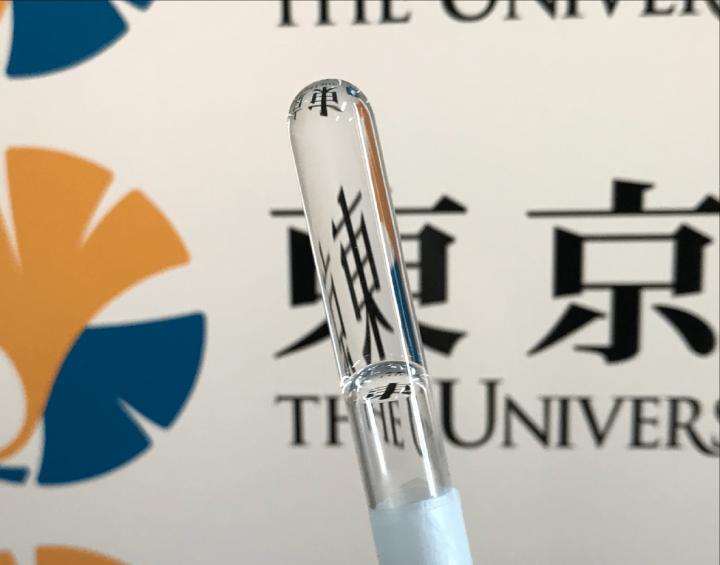A new kind of soft elastic material has medical and technological applications

Credit: Image: © 2019 Li et al.
Gel-like materials have a wide range of applications, especially in chemistry and medicine. However, their usefulness is sometimes limited by their inherent random and disordered nature. Researchers from the University of Tokyo’s Institute for Solid State Physics have found a way to produce a new kind of gel which overcomes this limitation. It is still malleable and adaptable like existing gels, but it has a more ordered structure, which can open up a new range of possible uses in various fields.
When you hear the word “gel,” you probably conjure up the image of something wobbly and viscous like some cosmetic substance or the inside of a memory-foam mattress. But in the world of scientific research, gels have a more specific definition. Strictly speaking, gels are three-dimensional networks of polymers — chains of molecules — with microscopic pores between these chemical strands. The nature and arrangement of these polymers give gels different functions leading to common applications, such as chemical filtration or drug delivery.
The creation of polymer network gels is difficult to control, so they are very disordered and contain many structural inconsistencies or defects. They are said to be heterogeneous, meaning their forms vary widely throughout their structures. However, Research Associate Xiang Li and colleagues have found a novel way to maintain a high level of order while fabricating polymer gels. The result is a homogeneous gel, one that is more consistent throughout its structure whilst still providing the benefits of a highly porous and malleable material.
“We demonstrated that it’s actually quite easy to synthesize an extremely homogeneous gel network,” said Li. “First, we tightly packed some star-shaped polymers together in a solvent and added some chemicals which, when activated, join these star polymers together. We activated the joining or ‘cross-linking’ chemicals in a controlled manner; this in turn led to a more ordered polymer gel network than one might ordinarily expect from this kind of process.”
The fabrication process, based on a concept known as bond percolation, is very effective at producing ordered gel networks — so much so that researchers feel it forces them to redefine what actually constitutes a gel. Previously a gel was assumed to contain disorder and defects, however these are no longer key properties. But all this work is not just for the sake of making something new; it has a strong purpose and it could lead to some interesting advancements.
“Ordered yet flexible gel networks could be used in applications like high-performance chemical filters, flexible sensors, mechanical actuators, controlled drug release and even ultraclear optical fibers,” explained Li. “We want to encourage others to build on our work here and find other ways to synthesize new polymer gels based on what we have started. Although our method was very specific, it lays the foundations for a more general experimental platform.”
###
Journal article
X. Li, S. Nakagawa, Y. Tsuji, N. Watanabe, M. Shibayama. Polymer gel with a flexible and highly ordered three-dimensional network synthesized via bond percolation.
Science Advances. DOI: 10.1126/sciadv.aax8647
This work was supported by the Japan Society for the Promotion of Science (JSPS) KAKENHI grant numbers JP16H02277, JP17K14536, and JP19K15628.
Institute for Solid State Physics
http://www.
Research Contact
Research Associate Xiang Li
Institute for Solid State Physics, The University of Tokyo
5-1-5 Kashiwanoha, Kashiwa, Chiba 277-8581 JAPAN
Tel: +81-4-7136-3419
Email: [email protected]
Press Contacts
Ms. Madoka Mochida
Institute for Solid State Physics, The University of Tokyo
5-1-5 Kashiwanoha, Kashiwa, Chiba 277-8581 JAPAN
Email: [email protected]
Mr. Rohan Mehra
Division for Strategic Public Relations, The University of Tokyo
7-3-1 Hongo, Bunkyo-ku, Tokyo 113-8654, JAPAN
Tel: +81-3-5841-0876
Email: [email protected]
About the University of Tokyo
The University of Tokyo is Japan’s leading university and one of the world’s top research universities. The vast research output of some 6,000 researchers is published in the world’s top journals across the arts and sciences. Our vibrant student body of around 15,000 undergraduate and 15,000 graduate students includes over 4,000 international students. Find out more at https:/
Media Contact
Xiang Li
[email protected]
81-471-363-419
Original Source
https:/
Related Journal Article
http://dx.




